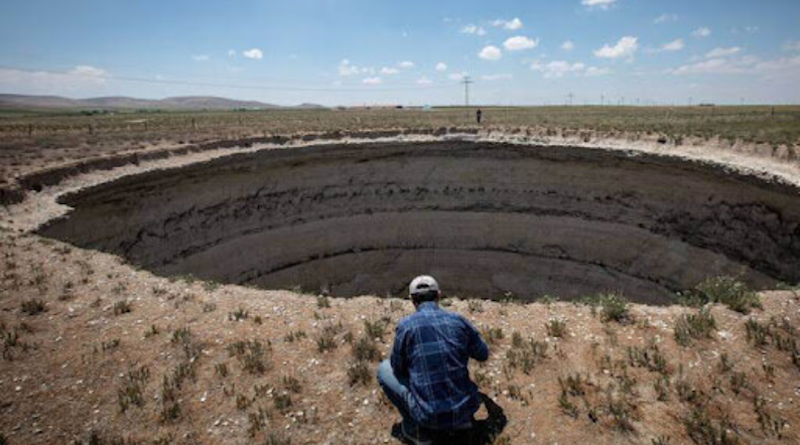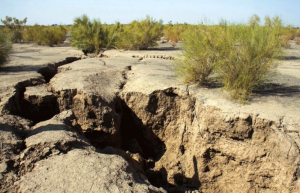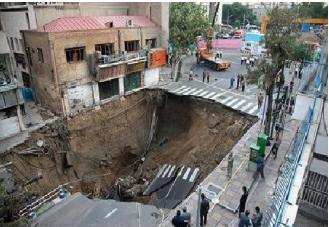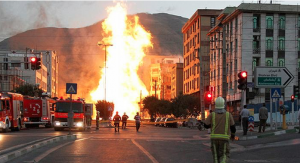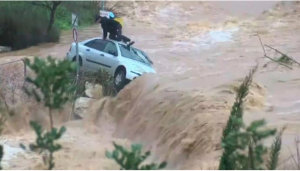Iran’s Environmental Catastrophes: Landfall, Subsidence, And Sinkholes – OpEd
Land subsidence is a global phenomenon involving the gradual settling or sudden sinking of ground surface owing to the movement of earth materials. This geological hazard, which is called “silent earthquake” can be induced by natural factors like tectonics, consolidation of the soil, chemical and physical processes of the ground.
Land subsidence is the lowering of the land-surface elevation due to changes that take place underground. It occurs when large amounts of groundwater have been withdrawn from certain types of rocks, such as fine-grained sediments. So, Despite all these causes, groundwater withdrawal is the main trigger of land subsidence.
The rock compacts because the water is partly responsible for holding the ground up. When the water is withdrawn, the rocks falls in on itself. Man may not notice land subsidence too much because it can occur over large areas rather than in a small spot, like a sinkhole. Of course, it doesn’t mean that subsidence is not a big event.
Many places of the world have suffered damage to the tune of hundreds of millions of dollars over the years. Several cases around the world have revealed that subsidence induced by the extraction of groundwater occurs mostly in areas, where there are relatively recent alluvial, marine, or lacustrine deposits constituted by alternation of coarse-grained water-bearing strata with fine-grained compressible layers.
Land subsidence, which is a gradual settling or sudden sinking of the Earth’s surface due to subsurface movement of earth materials, is mainly caused by aquifer-system compaction, drainage, and decomposition of organic soils, underground mining, oil and gas extraction, hydro compaction, natural compaction, sinkholes, and thawing permafrost.
Groundwater is a part of the natural water cycle. Some part of the precipitation that lands on the ground surface infiltrates into the subsurface. The part that continues downward through the soil reaches saturated groundwater, and recharges groundwater. Water in the saturated groundwater system moves slowly and may eventually discharge into streams, lakes, and oceans.
Ground subsidence that results in settlement or collapse of the ground surface is grouped into four main categories: (1) subsidence due to man-made voids and natural voids relatively close to the surface (coal mining, stone mining, or karstic features), (2) subsidence due to the removal of fluids from depth (water/oil extraction) and the consequential change in effective stress conditions, (3) subsidence due to the removal of soluble minerals (salt, gypsum) in groundwater, and (4) subsidence due to the removal of fines in suspension (piping). Subsidence additionally may occur due to alluvial deposits, shrink/swell, volcanism, and thermokarst.
Sinkhole collapse and karst subsidence are similar in morphology or process and are caused by dissolution of underground soluble bedrock (soluble carbonate and evaporite rocks), voids caused by removal or washout of subterranean material or decaying buried organic material.
Carbonate stone is dissolved or weakened by acid rains or significant movement (flow and volume) of groundwater or waterways. Over time, this weakened sediment and carbonate rock formation can collapse suddenly, resulting in a sinkhole formation. These sinkholes are natural hazards but do not depend on a single extreme weather event such as a flood.
A sinkhole is a collapsing cavity occurring as a result of loss of subsurface support from ongoing dissolution followed by a sudden collapse of top level soil. Sinkhole collapses generally occur without any warning or anticipation and are hard to predict without sophisticated geological instruments, such as ground penetrating radar, to detect the cavities and weakening of rock formations. Although sinkhole collapse is a natural hazard, a broken underground water pipe can wash away underground soil forming a cavity that can also lead to a collapse.
Karst subsidence is sinking of land that occurs as a result of gradual dissolution of soluble surface or subterranean material on bedrock. Unlike sinkhole collapse, it is a slow and gradual process and is less likely to cause any immediate damage or loss of life.
The large sinkholes can span several meter in diameter and depth. Many sinkholes are round in shape due to an hour-glass shaped flow of collapsing cover material into the underground cavity or caves formed by the dissolution process. Filling large sinkholes can be challenging and requires several geological considerations.
More than 80% of the identified subsidence anywhere has occurred because of exploitation of underground water, and the increasing development of land and water resources threatens to exacerbate existing land subsidence problems and initiate new ones. Human intervention is the most important factor causing land subsidence in any country. It is expected due to such hazards, authorities take measures to reduce the pressure on the environment.
In many arid areas, and in more humid areas underlain by soluble rocks such as limestone, gypsum, or salt, land subsidence is an often-overlooked environmental consequence of land and water use practices. As the land sinks, flooding problems are aggravated.
Compaction of soils in some aquifer systems can accompany excessive groundwater pumping and it is by far the single largest cause of subsidence. Excessive pumping of such aquifer systems has resulted in permanent subsidence and related ground failures. In some systems, when large amounts of water are pumped, the subsoil compacts, thus reducing in size and number the open pore spaces in the soil that previously held water. This condition will result in a permanent reduction in the total storage capacity of the aquifer system.
Climate variation in terms of global warming, whether natural or anthropogenic, can indirectly cause glacial isostatic adjustments (uplift and subsidence) of the Earth’s crust related to melting of ice sheets, or can thaw permafrost with subsequent loss of ice volume and drainage of shallow groundwater leading to mechanical and even oxidation mediated subsidence. Climate variation may result in either reductions (droughts) or enhancements (wet periods) of precipitation, surface runoff and groundwater recharge. The reductions can cause subsidence owing to lowered groundwater levels contributing to aquifer system compaction and to oxidation and consolidation of organic soils; enhancements can cause subsidence owing to increased dissolution of karst minerals and reduced mechanical support for pre-existing karst features.
Subsidence, which also is called quiet earthquake, results in significant economic loss in the form of structural damage and high maintenance costs. This affects roads and transportation networks, hydraulic infrastructure, sewage systems, buildings, and foundations. The total damage worldwide is estimated at billions of dollars annually.
Iran nowadays has faced with severe subsidence in most of its plains. The rate of land subsidence in the country is increasing day by day, while the performance of the responsible bodies is not satisfactory.
Environmentalists and land experts are emphasizing the need to review the operation of wells, groundwater withdrawal, and water resources management. Some 29 provinces are currently at risk of subsidence. If this trend is not stopped, there will be regrettably great irreversible environmental degradation.
Iran’s Geological Organization is monitoring more than 100 points of 44 regions in the country in terms of subsidence, and all data have been sent to the relevant authorities, but no attention has been paid to reduce this environmental hazard.
Iran’s immediate way out of its environmental crisis are to ban excess extraction of water from underground resources, a scientific review of surface water use, a critical review of IRGC water transfer system, and finally implement plans for the maintenance of land reserves.
The Iran’s Clerical Regime has no plan for collection and harvesting of flash floods as man has witnessed economic devastation, loss of lives, and massive destruction of homes and country’s infrastructures past few years. The government’s neglegence, and its systematic natural resources mismanagement can clearly been seen since 1979, the inception of Islamic Republic.
Groundwater exploitation has dramatically been increased over the past decades leading to aquifer depletion. Iran’s government has claimed persistent droughts for water crises, which are mostly due to plundering of water resources, enormous dams construction, massive deforestation, destruction of rangelands due to overgrazing, persistent land subsidence, and desertification.
The head of Geological Survey and Mineral Exploration said: 80% of the groundwater is withdrawn annually in Iran, which outpacing the global rate. In the world, water resources withdrawal is between 3 to 20%, and when it reaches 40 to 60%, which is considered problematic, and it will be a crisis when exceeding 60-80%.
Over the past decades, some of the aquifer levels dropped by 100 centimeters. In addition to digging illegal wells, improper irrigation methods are the other main causes of groundwater extraction-induced subsidence, as out of 50,000 wells pumping underground water resources in the capital, 30,000 are illegal. Out of 609 plains in Iran, more than 300 are vastly sinking and forbidden to enter.
It should be noted that over the next 40 years, Iran’s temperature will rise by 2.6 degrees on Celsius Scale, which will increase the country’s need for more water resources.
According to a study carried out by the Transport, Housing, and Urban Development Research Center of Iran, some 18 densely populated provinces are vastly subsiding and consequently, become increasingly vulnerable to flooding and natural incidents as well as bearing huge infrastructure damage.
Provinces of Isfahan, Tehran, Kerman, Khorasan Razavi, Alborz, Fars, Yazd, Hamedan, Markazi, Chaharmahal-Bakhtiari, East Azerbaijan, Zanjan, Qom, Ardabil, Kurdistan, West Azerbaijan, North Khorasan, and Kermanshah reported the highest rates of subsidence, respectively.
Tehran is the most populous city in West Asia, which is sinking into the ground at an alarming rate. The metropolis is home to some 15 million people and is a victim of dramatic subsidence. New research reveals that the region is sinking by more than 25-45 centimeters annually in some parts.
Above paragraphs clearly a testimony that main contributing factor of land subsidence, landfall, and sinkholes in Iran are directly due to over extraction of groundwater. However, the country’s authorities are mute, and in absolute inaction.
It is a known scientific fact that water comes to us in two forms: 1) Surface water as rivers, springs, lakes, and oceans; 2) Subsurface water. Both of these two systems are feeding each other, misusing one will affect the other.
Under the clerical rule, IRGC, Religious Foundations under the supervision of Supreme Leader are the owners of country’s wealth, including water. Thus for, the existing environmental catastrophes, degradation, and deteriorations are the results of absolute corruption, plundering, and mismanagement of Iran’s natural resources.
The issue that this whole system doesn’t have in their agenda is the care for the welfare of Iranians as it can be depicted in their handlings of Iran’s economy, healthcare, COVID19, foreign policy, and other socioeconomic issues. However, they apply their utmost efforts to finance terrorism in the region and around the globe, human rights violations, deceptive nuclear, long range missile activities, and absolute suppression within Iran.
Now, the land also subsiding under the feet of mullahs due to unpopularity among Iranians, in the region, among neighboring countries, and its unresolved issues with the civilized world. Altogether, the clerical regime is an unfit governing system for Iran, the peace and security of the world due to its backward views of the universe and its support for islamic fundamentalism and extremism. So, it’s doing all inhumane behaviors to keep itself in power for few more days.
The Iran’s environmental crises wouldn’t be contained only within the country’s borders but also they will spill over and contribute to the global environmental crises. It, also certainly won’t be resolved as long as Clerics are in power. If humanity wants a relief of the Clerics abuse of human rights, fundamentalism, and the central bank of terrorism, they must have the courage to stand up with the Iranians and their resistance under the leadership of a courageous woman Mrs. Maryam Rajavi to overthrow this corrupt Islamic Regime.
* Khalil Khani is an Environmental Specialist and a Human Rights activist. He holds a Ph.D. in Ecology, Botany, and Environmental Studies from Germany and has taught at the University of Tehran and the Hesse State University in Germany. He is also a Doctor of Medical Psychology from the United States.

